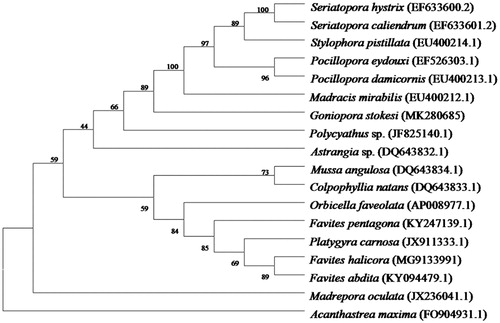Abstract
In this study, the complete mitogenome sequence of the Goniopora stokesi, has been sequenced by next-generation sequence method. The overall of Goniopora stokesi mitogenome is 37.25% for A, 23.46% for C, 13.61% for G, and 25.68% for T, as well as 37.07% for low GC. The assembled mitogenome, consisting of 18828 bp, has unique 13 protein-coding genes (PCGs), 2 transfer RNA genes, and 2 ribosomal RNA genes. The complete mitogenome provides essential and important DNA molecular data for further phylogenetic and evolutionary analysis of stony coral phylogeny.
Keywords:
Goniopora stokesi belongs to the family of Goniopora. They are widely distributed throughout the Indo-Pacific and South China Sea. They usually are found free-living on soft substrates. The colonies of these species are free-living or attached and hemispherical or (rarely) have short thick columns. The color of these species is usually pale brown or green with green tentacle tips (Veron and Stafford-Smith Citation2000). The first establishment of G. stokesi mitogenome is important for further evolutionary and phylogenetic analysis of stony coral.
Samples (voucher no. YM02) of G. stokesi were collected from Yang Meikeng sea area Daya Bay (22.5428°N, 114.5928°E) in Shenzhen, China. We used next-generation sequencing to perform whole genome sequencing according to the protocol (Niu et al. Citation2016).
The complete mitogenome of G. stokesi was 18828 bp in size (GenBank MK280685) and its overall base composition is 37.25% for A, 23.46% for C, 13.61% for G, and 25.68% for T, and with 37.07% content low GC. Circular form of complete mitogenome with about an average 202× coverage.
The protein coding, rRNA and tRNA genes of G. stokesi were predicted by using rRNAmmer (Lagesen et al. Citation2007), tRNAscan (Lowe and Eddy Citation1997) and DOGMA (Wyman et al. Citation2004) tools and manually inspected. The complete mitogenome of G. stokesi includes unique 13 protein-coding genes (PCGs), 2 transfer RNA genes, and 2 ribosomal RNA genes. All genes including 13 PCGs share the start codon ATG, except for NAD5, NAD4L (with GTG start codon), NAD6 (with ATA start codon), NAD3 (with ATC start codon). All the 13 PCGs share the stop codon TAA, except for ATP6, COX3, COX2, NAD3, COX1 (with TAG stop codon). Among 13 PCGs, the longest one is NAD4 gene (1476 bp), whereas the shortest is ATP8 gene (216 bp). The size of small ribosomal RNA (12S rRNA) and large ribosomal RNA (16S rRNA) gene are 1108 bp and 2382 bp, respectively.
To validate the phylogenetic position of G. stokesi, we used MEGA 6.0 software (Tamura et al. Citation2013) to construct a maximum-likelihood tree (with 1000 bootstrap replicates and kimura 2-parameter model) containing complete mitogenomes of 17 species derived from 13 different families in Scleractinia. Corallimorphus profundus derived from Corallimorphidae was used as outgroup related to G. stokesi coral with high bootstrap value supported (). In conclusion, the complete mitogenome of G. stokesi deduced in this study provides essential and important DNA molecular data for further phylogenetic and evolutionary analysis for stony coral phylogeny.
Figure 1. Molecular phylogeny of Goniopora stokesi and other related species in Scleractina based on complete mitogenome. The complete mitogenome is downloaded from GenBank and phylogenic tree is constructed by maximum-likehood method with 1000 bootstrap. The gene’s accession number for tree construction is listed as follow: Seriatopora hystrix (EF633600.2), Seriatopora caliendrum (EF633601.2), Stylophora pistillata (EU400214.1), Pocillopora eydouxi (EF526303.1), Pocillopora damicornis (EU400213.1), Madracis mirabilis (EU400212.1), Goniopora stokesi (MK260685), Polycyathus sp. (JF825140.1), Astrangia sp. (DQ643832.1), Mussa angulosa (DQ643834.1), Colpophyllia natans (DQ643833.1), Orbicella faveolata (AP008977.1), Favites pentagon (KY247139.1), Platygyra carnosa (JX911333.1), Favites halicora (MG9133991), Favites abdita (KY094479.1), Madrepora oculata (JX236041.1), Acanthastrea maxima (FO904931.1).

Disclosure statement
The authors report no conflicts of interest. The authors alone are responsible for the content and writing of the paper.
Additional information
Funding
References
- Lagesen K, Hallin P, Rødland EA, Staerfeldt H-H, Rognes T, Ussery DW. 2007. RNAmmer: consistent and rapid annotation of ribosomal RNA genes. Nucleic Acids Res. 35:3100–3108.
- Lowe TM, Eddy SR. 1997. tRNAscan-SE: A program for improved detection of transfer RNA genes in genomic sequence. Nucleic Acids Res. 25:955–964.
- Niu WT, Lin RC, Shi XF, Chen CH, Shen KN, Hsiao CD. 2016. Next generation sequencing yields the complete mitogenome of massive coral, Porites lutea (Cnidaria: Poritidae). Mitochondr DNA B. 1:8–9.
- Tamura K, Stecher G, Peterson D, Filipski A, Kumar S. 2013. MEGA6: Molecular Evolutionary Genetics Analysis version 6.0. Mol Biol Evol. 30:2725–2729.
- Veron JEN, Stafford-Smith M. 2000. Corals of the world. Australian Institute of Marine Science.
- Wyman SK, Jansen RK, Boore JL. 2004. Automatic annotation of organellar genomes with DOGMA. Bioinformatics. 20:3252–3255.
